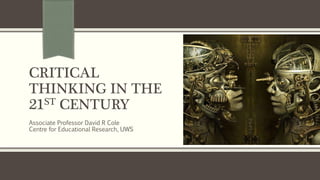
Critical thinking in the 21st century
- 1. CRITICAL THINKING IN THE 21ST CENTURY Associate Professor David R Cole Centre for Educational Research, UWS
- 2. Structure of the Talk Definition of Critical Thinking (CT) Recent history of CT – the Figuring Mind CT and Socratic method CT and philosophy CT, cognition and metacognition Differences between CT & CCT Stand-alone or embedded subject? The Essential Learnings (Tasmania) How to encourage CT in the classroom Strategies for CT practice …
- 3. Definition of Critical Thinking
- 4. Recent history of CT Ed Glaser’s , An Experiment in the Development of Critical Thinking (1941) Watson-Glaser Critical Thinking Appraisal Max Black’s, Critical Thinking (1946)
- 6. CT and Socratic method Socratic method: also known as method of elenchus, elenctic method, or Socratic debate, is named after the classical Greek philosopher Socrates. It is a form of inquiry and discussion between individuals, based on asking and answering questions to stimulate critical thinking and to illuminate ideas … Used in P4C: Children are taught how to create their own philosophical questions. They then choose one question that is the focus of a philosophical enquiry, or dialogue. For example the question might be: ‘is it ever ok to steal? ’ The teacher, as facilitator, supports the children in their thinking, reasoning and questioning, as well as the way the children speak and listen to each other in the dialogue. After the enquiry, the children and facilitator reflect on the quality of the thinking, reasoning and participation, and suggest how they could improve; either as individuals or as a group (community).
- 7. CT and philosophy All philosophers have used CT, however, CT is not a history of philosophy course : Empiricism: the theory that all knowledge is based on experience derived from the senses. Stimulated by the rise of experimental science, it developed in the 17th and 18th centuries, expounded in particular by John Locke, George Berkeley, and David Hume Rationalism: the theory that reason rather than experience is the foundation of certainty in knowledge
- 8. CT, cognition and metacognition CT is developed through cognition and metacognitive strategies in and across the subject areas … Research indicates that students can learn to engage in “meta-cognition” (thinking about thinking) if they are regularly asked self-assessment questions, which require reflection on their own thought processes. When students learn to routinely ask themselves these questions, the depth and quality of their thinking are enhanced (Resnick, 1986)
- 9. Differences between CT and CCT The Australian Curriculum includes the cross-curricula capacity of Critical and Creative Thinking (ACARA, 2012)
- 10. Stand-alone or embedded subject? The Theory of Knowledge subject is taught across the curriculum by the IBO and is included in every other subject through ‘ToK links’. Critical thinking only happens when students have sufficient knowledge/confidence/skill to enter into debate. CT is not only epistemology.
- 11. The Essential Learnings (Tasmania)
- 12. How to encourage CT in the classroom? Summarize or put into their own words what the teacher or another student has said. Elaborate on what they have said. Relate the issue or content to their own knowledge and experience. Give examples to clarify or support what they have said. Make connections between related concepts. Restate the instructions or assignment in their own words. State the question at issue. Describe to what extent their point of view on the issue is different from or similar to the point of view of the instructor, other students, the author, etc. Take a few minutes to write down any of the above. Write down the most pressing question on their mind at this point. The instructor then uses the above tactics to help students reason through the questions. Discuss any of the above with a partner and then participate in a group discussion facilitated by the instructor. Critical Thinking web site (2012)
- 13. Strategies for CT practice Promoting interaction among students as they learn - Learning in a group setting often helps each member achieve more. Asking open-ended questions that do not assume the "one right answer" - Critical thinking is often exemplified best when the problems are inherently ill-defined and do not have a "right" answer. Open-ended questions also encourage students to think and respond creatively, without fear of giving the "wrong" answer. Allowing sufficient time for students to reflect on the questions asked or problems posed - Critical thinking seldom involves snap judgments; therefore, posing questions and allowing adequate time before soliciting responses helps students understand that they are expected to deliberate and to ponder, and that the immediate response is not always the best response. Teaching for transfer - The skills for critical thinking should "travel well." They generally will do so only if teachers provide opportunities for students to see how a newly acquired skill can apply to other situations and to the student's own experience Potts, 1994
- 15. References ACARA (2012). General Capabilities in the Australian Curriculum. Available at: http://www.acara.edu.au accessed 11/2/2014 ― (Critical and creative thinking): pp. 53-63. Black, M. (1946). Critical Thinking: An Introduction to Logic and Scientific Method. New York: Prentice-Hall. Critical Thinking web site (2012). http://www.criticalthinking.org/pages/tactics-that- encourage-active-learning/468 Glaser, E.M. (1941). An Experiment in the Development of Critical Thinking, NY, Teacher’s College: Columbia University. Potts, Bonnie (1994). Strategies for teaching critical thinking. Practical Assessment, Research & Evaluation, 4(3). Retrieved June 1, 2015 from http://PAREonline.net/getvn.asp?v=4&n=3 Resnick, L. B. (1986). Education and learning to think. Special Report. Pittsburgh: University of Pittsburgh, Commission on Behavioral and Social Sciences and Education.
Editor's Notes
- NOTE: Want a different image on this slide? Select the picture and delete it. Now click the Pictures icon in the placeholder to insert your own image.
